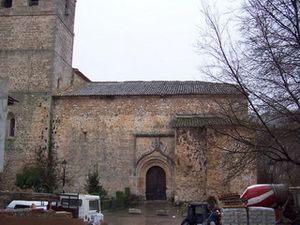Church of la Virgen de la Asunción (Romancos) facts for kids
Quick facts for kids Church of la Virgen de la Asunción |
|
|---|---|
| Native name Spanish: Iglesia Parroquial de la Virgen de la Asunción (Romancos) |
|
 |
|
| Location | Romancos, Brihuega, Spain |
| Official name: Iglesia Parroquial de la Virgen de la Asunción (Romancos) | |
| Type | Non-movable |
| Criteria | Monument |
| Designated | 1990 |
| Reference no. | RI-51-0007005 |
| Lua error in Module:Location_map at line 420: attempt to index field 'wikibase' (a nil value). | |
The Church of la Virgen de la Asunción (which means "Church of Our Lady of the Assumption" in Spanish) is a beautiful old church. You can find it in a small town called Romancos, near Brihuega, in Spain. This church is very special because it was officially recognized as a Bien de Interés Cultural in 1990. This means it's a really important historical and artistic treasure for Spain!
Contents
Building a Historic Church
The Church of la Virgen de la Asunción was built a long, long time ago. Construction started in the late 1400s and finished in the early 1500s. Imagine, that's over 500 years ago! Building such a large and detailed church back then was a huge project. It took many skilled workers and a lot of time.
What is Gothic Architecture?
The church was built in a style called late-Gothic. Gothic architecture was popular in Europe from the 12th to the 16th centuries. It's known for its tall, pointed arches, ribbed vaults, and large stained-glass windows. These features made churches feel very grand and let in lots of light. Gothic buildings often had flying buttresses too, which are supports on the outside walls. These helped the tall walls stand strong.
The Isabelino Style
Specifically, this church shows the Isabelino style. This was a unique type of Gothic architecture found in Spain during the time of Queen Isabella I of Castile. The Isabelino style mixes traditional Gothic ideas with influences from Spanish and Moorish art. You might see more detailed decorations, often with symbols like coats of arms or special patterns. It makes the buildings look very rich and unique.
Why This Church is Important
In 1990, the Church of la Virgen de la Asunción was given a special title: Bien de Interés Cultural. This Spanish title means "Asset of Cultural Interest." It's like saying the church is a national treasure. This protection helps make sure the church is preserved for future generations. It means the building is important for its history, art, or architecture.
A Glimpse into the Past
Visiting the Church of la Virgen de la Asunción is like stepping back in time. It helps us understand how people lived and built things centuries ago. The church stands as a reminder of the rich history and artistic traditions of Spain. It's a place where history comes alive through its ancient stones and beautiful design.
See also
 In Spanish: Iglesia de Nuestra Señora de la Asunción (Romancos) para niños
In Spanish: Iglesia de Nuestra Señora de la Asunción (Romancos) para niños

